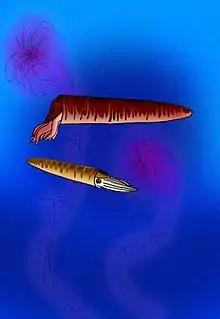| Troedssonellidae | |
|---|---|
 | |
| Comparison of Buttsoceras and Oxfordoceras | |
| Scientific classification | |
| Kingdom: | |
| Phylum: | |
| Class: | |
| Subclass: | |
| Order: | |
| Family: | Troedssonellidae Kobayashi 1935 |
| Genera | |
| |
Troedssonellidae is a family of orthoceroid cephalopods from the Ordovician, derived from rod-bearing Baltoceratidae, that have a continuous lining within the siphuncle that resembles very thin and slender endocones. Shells are generally slender and orthoconic. The siphuncle is central or subcentral, composed of straight or slightly expanded segments. Septal necks generally short and connecting rings are thin. Thin cameral deposits (lining the chambers) are known, which along with the position of the siphuncle and thin connecting rings distinguishes them from the endocerids in which they have been included.[1][2]
Troedsonnellids first appear high in Lower Ordovician (Cassinian) strata, beginning with Tajaroceras and extend at least through the Whiterock Stage of the Middle Ordovician.[2][3] They also may have given rise to the Striatoceratidae and to the Narthecoceratidae of the Middle and Late Ordovician.[2]
Genera
- Tajaroceras
- Buttsoceras
- Oxfordoceras
- Ctenoceras
- Troedsonnella
Genera of dubious placement:
- Glenisteroceras
- Wolungoceras
References
- ↑ Sweet 1964 Nautiloidea -Orthocerida in the Treatise on Invertebrate Paleontology, Part K, Teichert and Moore(eds)
- 1 2 3 Flower 1976. Ordovician Cephalopod Faunas and Their Role in Correlation, in The Ordovician System: proceedings of a Palaeontological Association symposium, Sept 1974
- ↑ Hook and Flower 1977. Late Canadian (Zones J,K) Cephalopod Faunas from Southwestern United States: Memoir 32, New Mexico Bureau of Mines and Mineral Resources.